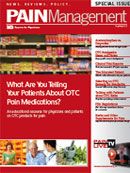Publication
Article
Pain Management
Reliable Online Resources on OTC Analgesics for Patients
With so much health care information online, it can be hard sometimes for patients to tell which websites and resources provide reliable and accurate information, especially when it comes to complex topics such as the risks and benefits of different OTC options for pain.
With so much health care information online, it can be hard sometimes for patients to tell which websites and resources provide reliable and accurate information, especially when it comes to complex topics such as the risks and benefits of different OTC options for pain. This page features a useful collection of links to online resources for patients who want to learn more about the safe use of OTC pain medications.
Acetaminophen
The Acetaminophen Awareness Coalition: Know Your Dose
The Know Your Dose campaign educates patients and consumers about the appropriate use of acetaminophen. The campaign is organized by the Acetaminophen Awareness Coalition—“a group of health, healthcare professional, and consumer organizations working to educate patients and consumers about acetaminophen so that it is only used as directed or labeled.” http://bit.ly/iO5beg
Rx and OTC Medications Containing Acetaminophen
A glance at this handy chart, which is designed to serve as a guide and is not meant to be a comprehensive directory of all available acetaminophen-containing products, should give patients an idea of just how many acetaminophen-containing products there are on the market. http://bit.ly/v3YCss
Ibuprofen and other NSAIDs
Understanding Ulcers, NSAIDs, and GI Bleeding: A Consumer Health Guide from the American College of Gastroenterology
This excellent resource from the ACG explains the symptoms and different types of GI bleeding, the symptoms and complications of ulcers, and issues associated with the use of NSAIDs. http://bit.ly/rwh8uR
Ulcers and GI Bleeding: What You Need to Know about the Safe and Appropriate Use of Common Pain Medications
This resource explains that a major cause for ulcers is irritation of the stomach arising from regular use of NSAIDs, including common OTC products that contain aspirin, ibuprofen, and naproxen. http://bit.ly/rqLr8p
Connecting with Your Physician to Reduce NSAID Risks: A Patient Discussion Guide
Patients can use this guide to facilitate discussions during their next office visit about the gastrointestinal risks associated with the use of ibuprofen and other NSAIDs. http://bit.ly/tEnDM0
General OTC Safety
The Appropriate Use of Common OTC Analgesics and Cough and Cold Medications
Although this monograph, created by the American Academy of Family Physicians and the American Pharmacists Association, was intended for clinicians, it offers a wealth of detailed information about the safety, effectiveness, and side effects of OTC products, along with advice and guidance on their appropriate use. http://bit.ly/vx4Kl1
American Chronic Pain Association Consumer Guide to Pain Medication and Treatments 2011
The section of this guide that covers the use of OTC pain medications reminds patients that “the key to the effective use of OTC medications is understanding what you are taking and how much of it. You need to read the medication’s ingredients to know what you are taking. Be sure that the medication you select contains an appropriate amount of the drug you need for your symptoms and does not include medications or ingredients you do not need.” http://bit.ly/jmPwxe
OTCSafety.org
Designed to provide education on the appropriate and safe use of OTC medicines and nutritional supplements, this site offers useful tips for the safe use of OTC medicines containing acetaminophen, aspirin, ibuprofen, naproxen, and topical pain relievers. http://bit.ly/dbb8hK
Be Label Smart
Part of the American Pain Foundation’s PainSAFE program, this excellent resource explains what information can be found on a drug facts label and why it is important for patients to take the time to read it. http://bit.ly/uvmOu5
FDA Guide to Safe Use of Pain Medicine
This print-friendly handout offers an overview of OTC pain medication types, tips on the safe use of pain medications, and information about misuse and abuse. http://1.usa.gov/u3w8Jn





